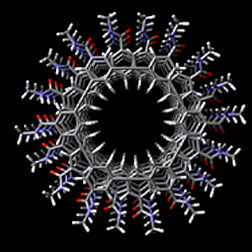- Number 368 |
- July 30, 2012
Artificial pores mimic key features of natural pores

art: anl_nanotubes.
Scientists have overcome key design hurdles to expand the potential uses of nanopores and nanotubes. The creation of smart nanotubes with selective mass transport opens up a wider range of applications for water purification, chemical separation and fighting disease.
Nanopores and their rolled up version, nanotubes, consist of atoms bonded to each other in a hexagonal pattern to create an array of nanometer-scale openings or channels. This structure creates a filter that can be sized to select which molecules and ions pass into drinking water or into a cell. The same filter technique can limit the release of chemical by-products from industrial processes.
Successes in making synthetic nanotubes from various materials have been reported previously, but their use has been limited because they degrade in water, the pore size of water-resistant carbon nanotubes is difficult to control, and, more critically, the inability to assemble them into appropriate filters.
An international team of researchers, with help of the Advanced Photon Source at DOE’s Argonne National Laboratory, have succeeded in overcoming these hurdles by building self-assembling, size-specific nanopores. This new capability enables them to engineer nanotubes for specific functions and use pore size to selectively block specific molecules and ions.
Scientists used groupings of atoms called ridged macrocycles that share a planar hexahenylene ethynylene core that bears six amide side chains. Through a cellular self-assembly process, the macrocycles stack cofacially, or atom on top of atom. Each layer of the macrocycle is held together by bonding among hydrogen atoms in the amide side chains. This alignment creates a uniform pore size regardless of the length of the nanotube. A slight misalignment of even a few macrocycles can alter the pore size and greatly compromise the nanotube’s functionality.
“It’s the first synthetic nanotube that has a very uniform diameter,” said Xiao Cheng Zeng, one of the study’s senior authors and an Ameritas professor at the University of Nebraska-Lincoln.[Jared Sagoff, 630.252.5549,
jsagoff@anl.gov]
